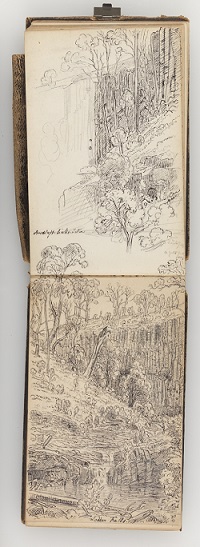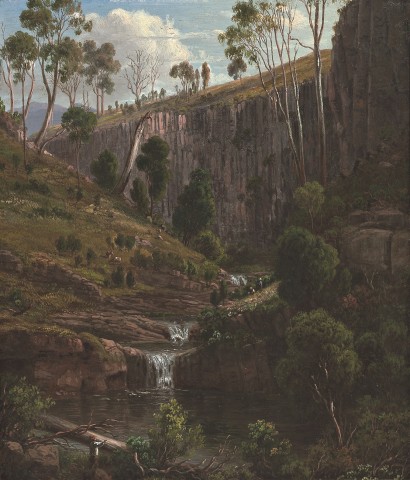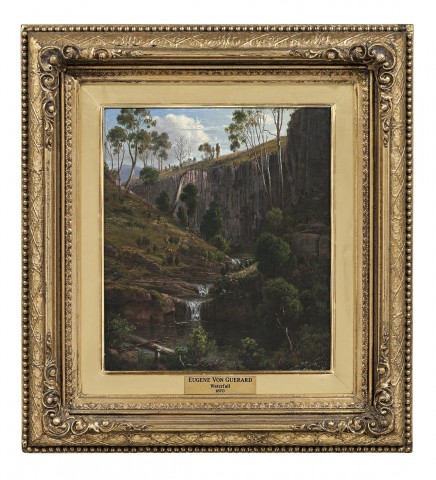RAVINE NEAR GLENLYON, UPPER LODDON, 1870
EUGENE VON GUÉRARD
oil on academy board
31.0 x 26.5 cm
signed with initials and dated lower left: E. v. G / 70
Henry Walker, Melbourne, 1872
Private collection, Sydney
Menzies, Melbourne, 14 September 2011, lot 30
Private collection, Sydney
The Second Exhibition of the Victorian Academy of Arts, Melbourne, 15 March 1872, cat. 67
Eugene Von Guérard: Artist – Traveller. The Sketchbooks of Eugene Von Guérard, Art Gallery of Ballarat, Victoria, 25 March – 27 May 2018 (label attached verso)
‘Exhibition of Paintings', The Age, Melbourne, 15 March 1872, p. 3
‘Victorian Academy of Arts: Second Notice’, The Argus, Melbourne, 22 March 1872, p. 7
‘Victorian Fine Art Exhibition’, Illustrated Australian News for Home Readers, Melbourne, 21 May 1872, p. 118
Bruce, C., Comstock, E. and McDonald, F., Eugene von Guérard, 1811–1901: a German Romantic in the Antipodes, Alister Taylor, Martinborough, 1982, cat. 137, p. 225
On the morning of 2 May 1868 Eugene von Guérard, one of Australia’s greatest nineteenth-century landscape painters, and William Stanbridge (1821 – 1894), a squatter and a leading figure in the Daylesford community, visited the picturesque waterfalls on the Upper Loddon near Glenlyon, 110 kilometres northwest of Melbourne. The site, on the traditional land of the Dja Dja Wurrung people, was already becoming known to European audiences: it had appeared in Antoine Fauchery and Richard Daintree’s album of photographs, ‘Sun Pictures of Victoria,’ in 1858; and a few months after von Guérard’s visit it was illustrated in The Australian News for Home Readers where it was described as one of the scenes ‘to be found along Australian mountain streams and along the line of our creeks, that offer to the artist’s pencil little morceaux of nature’s beauties’.1 The three sketchbook studies made on the day of his visit, one of them a highly resolved pencil and ink drawing on which von Guérard used a system of symbols to specify colours, indicate that from the outset he envisaged the Loddon Falls as the subject for a future painting.2
SLNSW Von Guerard.jpg

EUGENE VON GUÉRARD
Loddon Falls
(From Volume 14: Sketchbook
XXXV, No. 17 Australian, 1864-1865)
courtesy of Dixon Galleries,
State Library of New South Wales,
Sydney, cat. DGB16, v. 14, f. 19v.–20r
Von Guérard had spent the previous fortnight as the guest of Stanbridge at his Daylesford property, Wombat (the site of today’s Wombat Park). His visit was part of a six-week sketching expedition during which von Guérard and his wife and daughter were based at John Ware’s property, Yalla-y-Poora. In 1863 the Daylesford Record had expressed the hope that ‘at some not far distant date, Mons. Gaerrard [sic] … will visit this district and transfer to canvas some of the “beauty spots” in and about Daylesford’.3 Von Guérard’s visit resulted in four canvases: A View from Mount Franklin towards Mount Kooroocheang and the Pyrenees, c.1864, now in the collection of the Queensland Art Gallery, Breakneck Gorge, Hepburn Springs, 1864 and North View from Daylesford, 1864, all acquired by Stanbridge, and the present work.
In 1870, von Guérard returned to the compelling subject of the ravine near Glenlyon. His fascination with waterfalls began in his youth, in Italy, when he sketched the famous falls at Tivoli and Terni; it continued in Australia, with major works such as The Weatherboard Creek Falls, Jamieson’s Valley, NSW, 1862 and Waterfall, Strath Creek, 1862. The impact of the Loddon Falls is heightened by the spectacular walls of perpendicular basalt columns that frame them, and that attest to the volcanic activity that shaped the region. The scientifically accurate depiction of geological phenomena was fundamental to von Guérard’s philosophy of landscape painting and here the gesturing figure in the foreground directs our attention to the imposing columnar wall of basalt – which von Guérard identified in his diary – its joints and fractures clearly articulated and pink-hued in the morning light.4 A similar commitment to accuracy informs his depiction of the tree and plant species native to the site, with the slender manna gums and the compact, dark-foliaged blackwoods readily identifiable.
With his unerring instinct for composition, von Guérard found the vantage point from which the directional lines of the major landforms – the upper ridge line and the line of the slope on the left – intersect to create the dynamic diagonals on which Ravine near Glenlyon, Upper Loddon, 1870 is based. The dramatic zig-zag movement continues in the succession of stepped falls taken by the water as it flows over the rocky terrain.
By 1864, cattle had grazed, for over twenty years, on the grassy slopes of the ravine that for thousands of years previous had been an important source of fresh water, native fish and fauna for the Dja Dja Wurrung people. The Holcombe run, of which the ravine formed part, was established by Laurence Rostron snr, whose son von Guérard had met in Daylesford a few days earlier.5 During the 1850s, gold miners worked the site and a deep shaft still exists midway along the wall of rock. In von Guérard’s painting two small figures simply enjoy the view from the sunny bank in the middle ground – and perhaps the ‘Butterbrod’ (bread and butter) that, as von Guérard recorded, Stanbridge had brought along.
1. The Australian News for Home Readers, Melbourne, 24 September 1864, p. 7
2. Eugene von Guérard, Sketchbook no. XXXV, no. 17 Australia, 1864, ff. 19, 20, 21. Dixson Galleries, State Library of New South Wales, Sydney, DGB16, vol. 14
3. Daylesford Record, Saturday 11 April 1863. Cited in David Marshall, ‘Eugene von Guérard’s Views of the Daylesford Region for Mr William E. Stanbridge,’ The La Trobe Journal, Nos 93-94, 2014, p. 34, note 51, (p. 202)
4. Eugene von Guérard, Sketchbook XXXV, [f. 59]
5. Sketchbook XXXV, f.16; Marshall, 2014, p. 23 – 24.
RUTH PULLIN

